11/1/2017
Hot or Not
Jamie Tuinstra
 Advances in both greenhouses and unit heaters have substantially extended growing seasons, extending yields and dividends to growers. Unit heaters can allow greenhouses to be productive throughout even the harshest winters and greenhouses are turning out vegetables and flowers and other ornamentals from Michigan to upper Canada.
Advances in both greenhouses and unit heaters have substantially extended growing seasons, extending yields and dividends to growers. Unit heaters can allow greenhouses to be productive throughout even the harshest winters and greenhouses are turning out vegetables and flowers and other ornamentals from Michigan to upper Canada.
But the environments of greenhouses themselves can also be harsh and gas-fired unit heaters, while efficient to the point they can pay for themselves over time, need to be installed and maintained with care.
It’s a mistake, for instance, for even a relatively mechanically savvy greenhouse operator to attempt to install and vent these units. While they’re essentially little boxes that produce a lot of heat, their makeup and maintenance needs can be a little complicated. That’s why it’s best to leave installation to expert contractors.
Here’s a quick look at other mistakes commonly made with greenhouse unit heaters:
1. Incorrect sizing. There’s no single or simple square-foot formula to properly size greenhouse unit heaters. Many variables must be taken into account, including the greenhouse construction material, potential heat loss and the use of draped materials to enhance insulation. Proper sizing is key to efficient operation and should be handled by an expert. If the heater is too big for the space, this can lead to short-cycling—meaning the units cycle on and off too often, shortening their lifespan.
2. Failure to inspect. Unit heaters should have a years-long lifespan, but they must be properly cared for on a regular basis. Burners and heat exchangers need to be inspected and cleaned annually.
3. Improper pressure. Operators need to check pressure valves and fittings to ensure couplings are correct and operating at the correct amount of pressure. The biggest expense of virtually all greenhouse growers is the cost of the energy source needed to run the unit heaters. Incorrect pressure can waste natural gas or propane used to operate the units.
4. No redundancies. Even a small greenhouse should have more than one dedicated heating system. It only takes one night without heat in the dead of winter to turn your greenhouse produce or ornamentals into compost.
5. Improper siting. The unit heaters should be arranged at regular intervals around the interior perimeter of a greenhouse so that the warm air of one heater is blown into another and so on. This will create a vortex of heat that will wash the greenhouse walls with heat.
6. Condensate. There’s a tradeoff with high-efficiency unit heaters. The high-efficiency units produce condensate that cannot simply be recycled into the green-house plants because the condensate is highly acidic. It must be drained properly from the units, lest condensate freeze during a period of inoperation, cracking and damaging the unit. The condensate lines should be checked frequently to ensure they’re draining properly.
7. Improper venting. This can be another, dangerous side effect of failing to have a qualified contractor install your heater. Flue gases must be vented from the space. That’s not just for the safety of humans inside the greenhouse; some plants can be sickened by exhaust that’s not properly vented to the exterior.
8. Motor maintenance. The motor should be inspected regularly and oiled as needed. The motor is one of the most vital parts of the unit heater. If it fails, the unit won’t blow hot air and then the greenhouse crop is going to fail, too. Check power connections to the motor to make sure they’re secure and haven’t come loose.
9. Neglecting thermostats. Make sure you inspect your thermostat regularly, especially at the beginning of your greenhouse growing season. Make sure the thermostat is clean, inspect the wiring to and from the thermostat, and make sure temperatures are set properly.
10. Failing to inspect the gas supply. Make sure all gas connections are tightly fitted, including pilot tubing connections both at the valve and pilot burner. Inspect the main gas burners to make sure they’re not clogged by spider webs or debris.
This is just a general checklist and it should be reiterated that any maintenance should be performed by a professional contractor or installer. Keep a log of any maintenance and the date on which it was performed.
The longer your efficient greenhouse unit heater functions, the more money you’ll save over time. But like a greenhouse seedling, they need delicate and frequent attention. For a grower, there’s nothing less than a livelihood at stake. GT
Jamie Tuinstra is product manager for Modine Manufacturing Co. in Racine, Wisconsin.